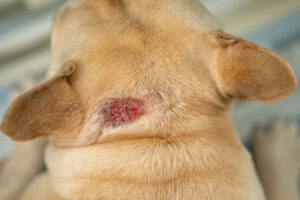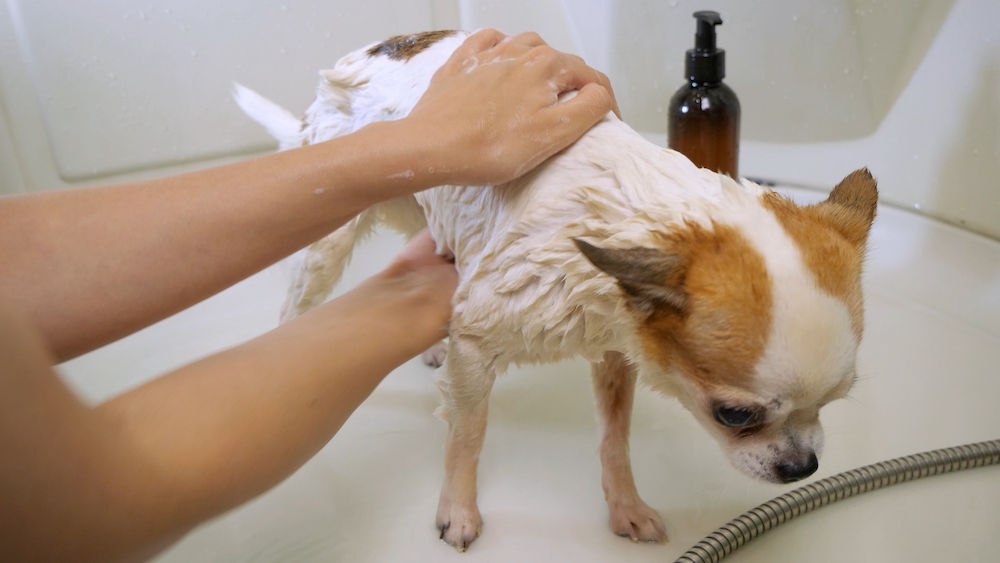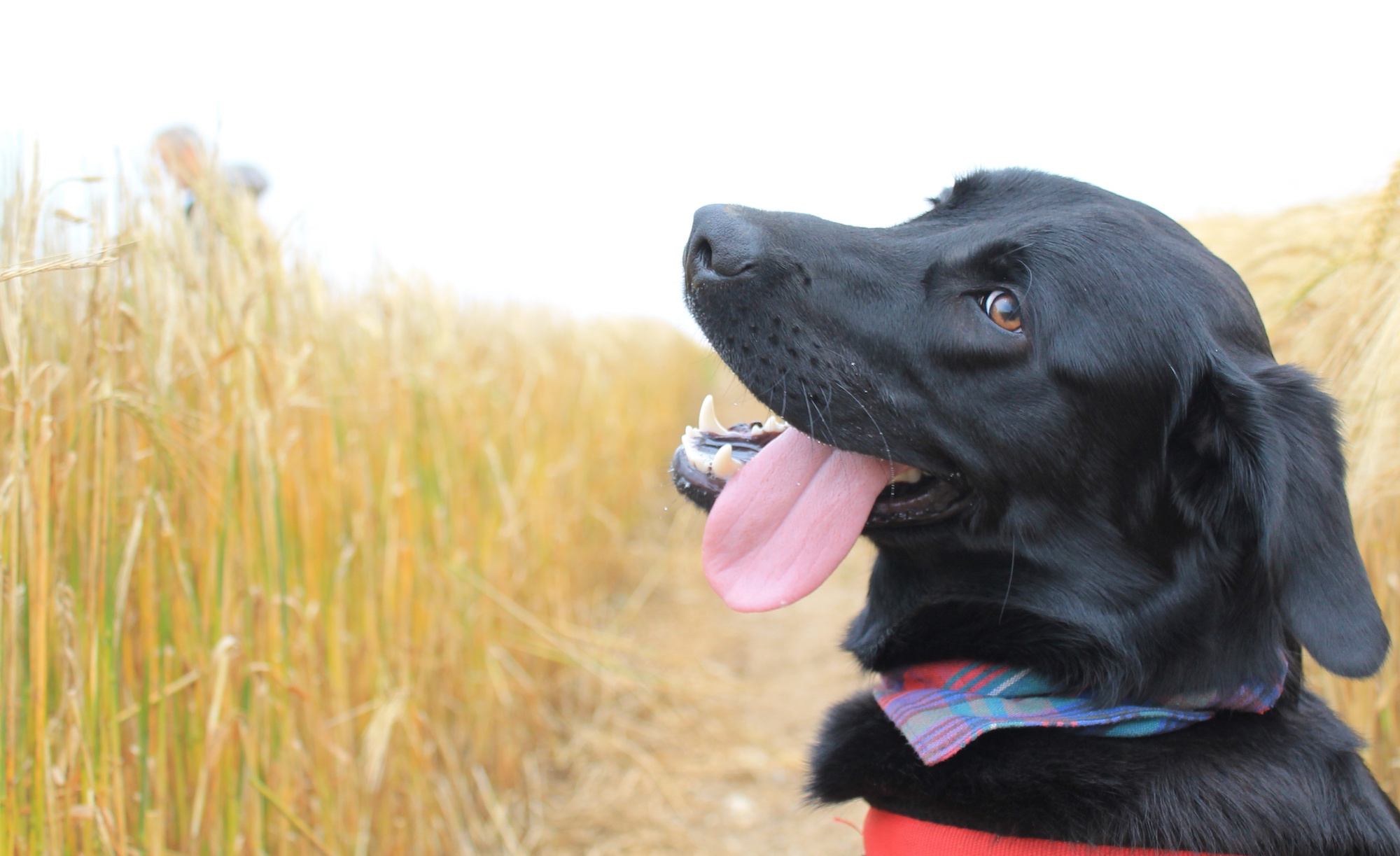If you see your dog scratching, licking, or biting themselves frequently, or if you notice an unfamiliar mark on their skin or fur, they may be dealing with a skin condition. A wide range of ailments can impact a dog’s skin—infections, immune issues, bug bites, and allergies are just a few of the possibilities. We’ve listed some of the common culprits below, along with information about how to identify and treat them. But remember: If you notice anything unusual that may have to do with your dog’s health, the best thing you can do is contact a veterinarian.
Fleas
If your dog has fleas, they may show that they’re feeling itchy by scratching, licking, rubbing, or chewing their skin. These can be signs of flea allergy dermatitis, which is brought on by the saliva in flea bites and is the most common skin ailment in American dogs.
Fleas and their eggs are very small, but you may spot evidence of them on your dog. Fleas’ droppings can appear as dark specks, while their eggs may look like white specks. If you see dark flecks on your dog and want to check whether they’re flea droppings, put them on a damp white paper towel. If they’re flea droppings, they’ll turn brown and then red as they absorb moisture.
Among other issues, dogs may contract tapeworms from fleas by eating them. If you suspect that your dog has fleas, it’s best to address the situation as soon as possible—speak with your veterinary care team to determine the best course of action.

Hot spots
Hot spots are irritated, inflamed areas on a dog’s skin. They tend to be wet, red, and warm, and may bleed or ooze fluids. They can be painful. The hot spots might cover just a small area at first, but then spread and get worse. Your dog may lose hair around the inflamed skin. Hot spots can start for all sorts of reasons, beginning as scratches from accidents or fights, bites, or stings, or itchy skin from allergies. Once a dog scratches, licks, or chews at the spot, it can grow and become infected with bacteria or fungus. Hot spots can also hide under fur—if an area looks wet or matted, there may be an infection or hot spot beneath it. Consult your vet to get to the bottom of the issue. Possible treatments include drugs, medicated shampoos, or an Elizabethan collar to stop your dog from scratching and licking the areas in question.
Atopic dermatitis (allergies)
Also known as “allergic dermatitis,” this is an allergic reaction to substances dogs get on their skin. Dogs with this condition are likely to scratch themselves a lot. Vets can help treat the symptoms of atopic dermatitis with antihistamines, anti-itch medications, and steroids, but over the long term you should work to protect your dog from whatever is triggering their reaction—this can involve keeping them away from certain environments, changing their bathing routines, or taking other measures depending on what’s irritating them. It may not be possible to avoid an allergen altogether, but reducing exposure can benefit a dog. Immunotherapy can also help some dogs.
Food allergies
Dogs who eat foods that they’re allergic to can experience itchy skin, along with many other issues. If your dog may be allergic to an ingredient in their food, talk to a vet about changing their diet.
Read more about allergies here.

Dry skin
Dogs can have dry skin—whose signs include, but are not limited to, itching, scabs, odors, and dandruff—for a variety of reasons, some of which are more serious than others. It could be brought on by harsh cleaning products, allergies, or a range of ailments that can be serious. If you notice that your dog’s skin seems to be dry, have them examined by a veterinarian as soon as possible to identify the problem and, if necessary, get them prompt treatment.
Dandruff (seborrhea)
Specifically, dandruff can be a result of seborrhea, in which dogs discharge large quantities of oils. In many cases, this is a genetic condition that can be treated with special shampoos; but it can also be a sign of a more serious issue, so it’s especially crucial to bring it to a veterinarian’s attention so that they can investigate. Other causes of seborrhea include food allergies, fungi, parasites, bacterial infections, improper nutrition, and dry air.
Ticks
Among the many possible signs that a tick has bitten your dog is irritation around the area where the dog’s been bitten. You may notice that a tick has gotten onto your dog before they show any signs of irritation, or you may not know it’s happened for a long time. Ticks can carry serious illnesses like Lyme disease, so you should check your dog for the parasites after you’ve spent time outside—especially in wooded areas or those with high grass or other dense vegetation. If you see a tick on your dog, remove it as soon as possible. And if you think your dog has been bitten, you should get them to a vet.
Mange
This skin disease is caused by mites, tiny parasites that live in hair follicles. Dogs suffering from it can be very itchy, lose hair, develop raised bumps, and have areas of thickened skin.
The most common type of mange in dogs is demodectic mange, which is caused by Demodex mites. Most dogs have these, but usually their immune systems can manage them. Some dogs, though, develop an overabundance that shows up as dry, irritated lesions and patches of hairlessness, often on the face or feet. They can be itchy and may cause secondary skin infections. Topical medication is often used to treat demodectic mange.
Sarcoptic mange, better known as scabies, is highly contagious between dogs—and can also infect people.
Yeast infections
Dogs whose skin is itchy and red, scaly and flaky, or thickened, and who have a musty odor, may be suffering from yeast infections. Dogs with yeast infections may scratch or lick themselves a lot, especially on areas like their ears or paws. The fungus that causes yeast infections is normally present on healthy dogs’ skin, but when it grows out of control it can cause problems. If your dog shows signs of a yeast infection, a vet may treat them with oral or topical medication, or by using immunotherapy. In most cases, treatment is very effective.
Ringworm
If your dog has circular areas of hair loss, they may be suffering from ringworm. Their hair and claws may also become brittle, and they may have scabs and other signs of inflammation on their skin.
Despite its name, this condition is actually not caused by a worm, but a fungus. It is very contagious—not only to dogs, but to other animals and humans—so be extra careful to exercise good hygiene around a dog with the parasite and seek treatment promptly. A vet will usually treat ringworm with topical and oral medication. It’s also important to thoroughly clean areas that have been contaminated with ringworm to prevent reinfection. The prognosis for dogs with ringworm is very good—their lives are not in danger—but you and they will be much more comfortable once the disease is resolved.
Acne
Humans aren’t the only ones who can get pimples—dogs, too, can suffer from acne. Canine acne is not too different from the human version. It’s a condition in which the skin on a dog’s muzzle and lips becomes inflamed. This can take the form of red bumps or pimples, and may also lead to swelling of the whole area.
Canine acne occurs when a hair follicle is irritated, as when a hair breaks and then grows under the skin surface. The follicle, or the tiny gland from which a hair grows, becomes inflamed, which invites bacterial infection.
Acne can include folliculitis (inflammation of hair follicles) and furunculosis (which can bring painful infections that may break and emit pus). It can strike any dog, but is most common in pups aged between 3 and 12 months.

Pyoderma
This condition, also known as impetigo, is a bacterial infection. Dogs with pyoderma may develop pimple- or hive-like lesions. Their skin may be itchy, red, and irritated, and they may lose some hair. Dogs with skin folds are vulnerable to a particular type of the infection that develops in that moist environment. It can arise on its own or as a complication of another condition—like untreated acne, atopy, or food allergies. Vets may treat pyoderma with antibiotics, special shampoos, and other types of medications.
Immune disorders
It’s unusual for an immune disease like lupus to be the cause of a dog’s skin problems—but, when it is the underlying reason, it’s life-threatening and requires immediate attention from a vet.
Skin cancer
If you notice a mark on your dog that’s new or changing, ask your vet about it. Like humans, dogs can develop cancerous lesions. And, like humans, their lives can be saved if those lesions are promptly identified and removed. There are many different types of skin cancer, and many different ways that they can appear. The safest course of action if you’re not sure about a mole, bump, rash, or blemish is to consult with your veterinary healthcare team about it.
This article was vetted by a vet.
Reviewed by Alex Schechter, DVM, founding veterinarian at Burrwood Veterinary.




